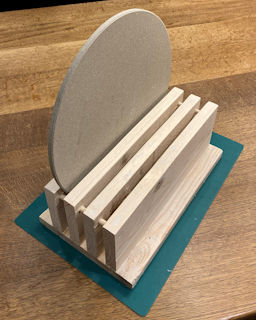Kiln shelves are brittle and should be stored standing on their edges. Some furniture was required to store three circular kiln shelves. I built it using scrap wood.
Design
I had some rough-sawn softwood boards of width 12 cm and thickness 25 mm, recovered from a palette. The circular shelves were of diameter 350 mm and thickness 10 mm. I calculated that if I used the boards to create slots with width 15 mm, the centre of gravity of the shelf would still fall within the slot. I also allowed for a base, made from wider 25 mm timber, that was about 3 cm wider than the combined width of the slots. I expected the design to be stable.
I had some spare 9 mm diameter dowel. I planned to pass the dowel through the slot boards about 10 cm from the base, both to constrain the shelf and strengthen the structure. The length of a chord is given by \(2\sqrt{r^2-d^2}\), where \(r\) is the radius and \(d\) is the shortest distance from the chord to the centre. Here, the radius is 175 mm and the distance is 75 mm. The chord is about 316 mm. I allowed a tolerance of about 4 mm.
Construction
I cut four slot boards of length 36 cm. I clamped the boards together to drill the holes (diameter 9.5 mm) through all the boards for the two dowels. Drilling was not straightforward; I drilled a sequence of holes with increasing bit diameters but should have started smaller and taken smaller steps between bit sizes.
I placed the dowels (without glue) and glued and screwed the slot boards to the base, using 15 mm lengths of dowel as spacers. I then fixed the dowels with glue, again using dowel spacers until the glue was set. The rough wood edges required a lot of sanding to make them smooth.
Strips of foam were placed in the centre of the bottom of the slots to further cushion the shelves as they were placed.
Result

The result was as I intended: a stable rack for the kiln shelves.